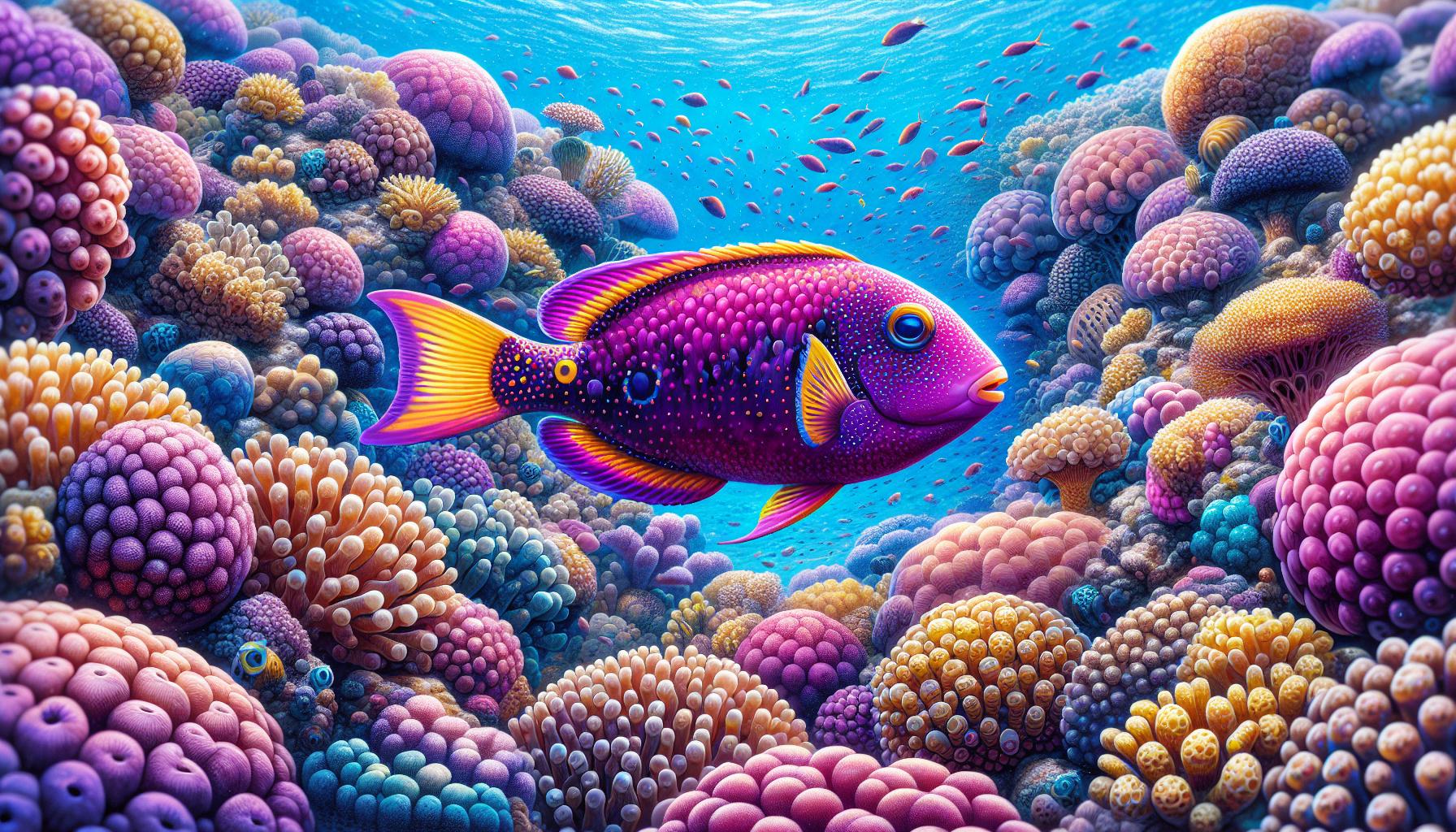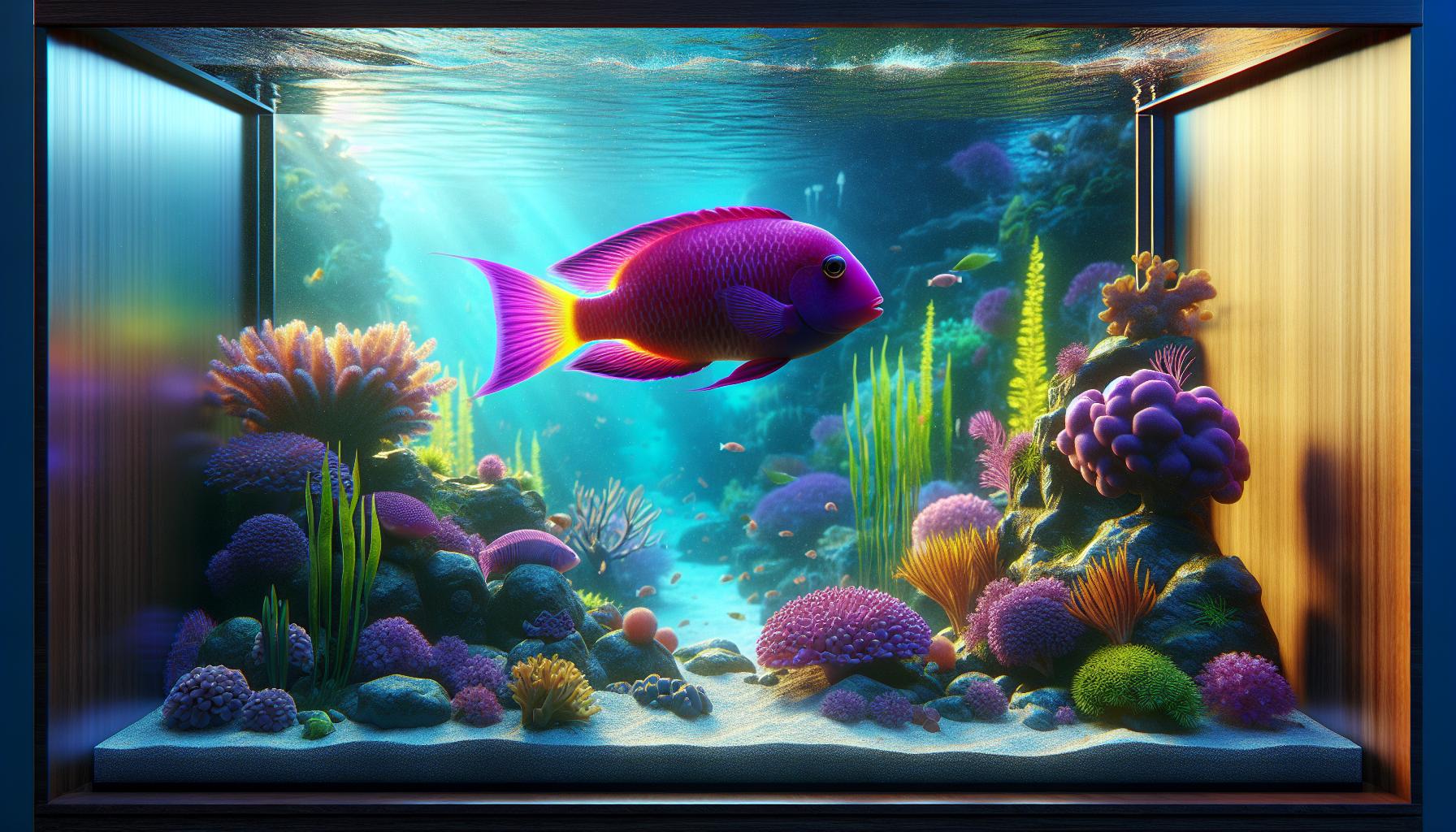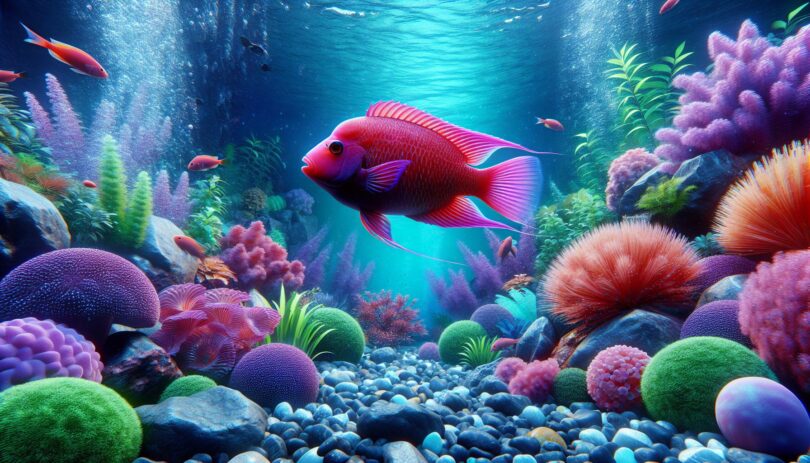Orchid Dottybacks, with their vibrant hues and fascinating behavior, have captivated my attention and that of many marine aquarium enthusiasts. These small, yet striking fish, native to the Red Sea, are a popular choice for reef aquariums due to their vivid purple coloration and resilient nature.
I’ve always been intrigued by the way Orchid Dottybacks blend into their colorful coral surroundings, making them a living piece of art in any tank. Their bold personality, coupled with their ease of care, makes them an ideal choice for both novice and experienced aquarists looking to add a splash of color and activity to their underwater worlds.
Key Takeaways
- Orchid Dottybacks are vibrant, purple-hued fish native to the Red Sea, making them a popular and visually striking choice for reef aquariums due to their coloration and resilient nature.
- Ideal tank setup for Orchid Dottybacks involves a minimum of a 30-gallon saltwater reef aquarium with ample hiding spaces and stable water parameters, including temperature (75-79°F), pH (8.1-8.4), and specific gravity (1.020-1.025).
- A balanced diet for Orchid Dottybacks consists of a mixture of meaty foods and high-quality prepared foods, with the inclusion of foods rich in carotenoids to maintain their vibrant coloration.
- Orchid Dottybacks exhibit territorial behavior, necessitating careful selection of tank mates to minimize aggression and ensure a harmonious aquarium environment.
- Preventive measures and regular monitoring for common diseases such as Marine Ich and Marine Velvet are crucial for maintaining the health of Orchid Dottybacks in captivity.
- Understanding Orchid Dottybacks’ reproductive behavior, such as their protogynous hermaphroditism, and providing an appropriate breeding environment can enhance the success of breeding efforts in captivity.
Identification and Physical Characteristics

When I first laid eyes on an Orchid Dottyback, its stunning appearance was something I couldn’t ignore. Recognized by their vibrant purple hue, these fish are a marvel in any reef tank. Typically, they reach about 3 inches in length, making them a perfect fit for a variety of tank sizes. But it’s not just their color that’s fascinating; their slender body and ability to dart quickly amongst corals are mesmerizing.
Identifying an Orchid Dottyback is relatively straightforward. Look for a fish with a deep, rich purple color that extends across its entire body. You might notice a slight variation in shading along the dorsal side, which can appear slightly lighter under intense aquarium lighting. Their eyes are small, yet alert, always scanning their surroundings.
I’ve been particularly interested in the morphological features that allow these fish to thrive in their native habitat, the Red Sea. Their streamlined body isn’t just for show; it enables them to navigate tight spaces among the corals, where they seek shelter and hunt for prey. Moreover, their coloration isn’t merely aesthetic but serves as camouflage against predators and when stalking their own prey.
Orchid Dottybacks are not just a treat for the eyes. They’re equipped with keen senses that make them adept at surviving in the wild and in captivity. Their lateral line system, though not as visible as in some other fish species, is highly developed. This sensory organ helps them detect movement and vibrations in the water, a crucial adaptation for both avoiding predators and capturing prey.
With their unique combination of beauty and brains, Orchid Dottybacks are more than just another fish in the sea. They’re a testament to the incredible diversity and adaptation of marine life, something that never ceases to amaze me as an avid aquarist and marine enthusiast.
Habitat and Distribution

When I explore the natural habitats of Orchid Dottybacks, it’s fascinating to unveil the specific environments these vibrant fish call home. Orchid Dottybacks are endemic to the Red Sea, thriving in waters that provide an ideal combination of temperature, salinity, and shelter. This unique geographic limitation means they are not found in the vast oceans beyond, making their conservation in the wild and presence in the aquarium trade particularly noteworthy.
These fish prefer reef environments, where intricate coral formations and rocky substrates abound. The complexity of reefs offers both safety from predators and abundant opportunities to hunt. Orchid Dottybacks adapt to this environment skillfully, utilizing their slender bodies to weave through tight spaces within the corals. It’s their sanctuary, a playground that caters to their survival and predatory instincts.
In the wild, they’re often observed at depths varying from shallow waters to about 40 meters below the surface. This range demonstrates their versatility and resilience in navigating through different aquatic conditions. Their presence across various depths also suggests an adaptability to changes in light and water pressure, showcasing a remarkable degree of environmental tolerance.
Orchids Dottybacks’ distribution, confined to the Red Sea, underscores the importance of preserving their natural habitat. With increasing threats to coral reefs globally, understanding where these fish live and the conditions they need to thrive is crucial for their protection and sustainable aquarium trade.
Their adaptation to specific reef environments, coupled with the limited geographical range, makes the Orchid Dottyback a fascinating subject for further research into marine biodiversity and the effects of habitat conservation on endemic species.
Tank Setup and Care

When I set up a tank for Orchid Dottybacks, I focus on mimicking their natural habitat to ensure they thrive in captivity. Given their preference for intricate reef environments, setting up a reef tank is fundamental. A tank size of at least 30 gallons is recommended to provide enough space for the fish and the live rock formations they’ll use for hiding and hunting.
Live rocks serve dual purposes in the tank: they’re crucial for replicating the natural reef structures Orchid Dottybacks are accustomed to, and they foster the growth of microorganisms that the fish can feed on. Lighting should be moderate to support the growth of corals and algae, creating a more natural environment for the Dottybacks and enhancing the tank’s aesthetic appeal.
Water parameters are paramount for the health of Orchid Dottybacks. I closely monitor these parameters to ensure they align with the conditions found in their natural habitat:
| Parameter | Ideal Range |
|---|---|
| Temperature | 75-79°F (24-26°C) |
| pH | 8.1-8.4 |
| Salinity | 1.020-1.025 specific gravity |
| Ammonia | 0 ppm |
| Nitrites | 0 ppm |
| Nitrates | < 20 ppm |
Regular water changes are a part of my routine, swapping out 10-15% of the tank water bi-weekly to maintain these parameters and remove waste products. This practice helps prevent the buildup of harmful toxins that can stress or harm the fish.
Compatibility with other marine life is another aspect I consider carefully. Orchid Dottybacks can be territorial, especially towards their own kind or similar-sized fish. Therefore, it’s essential to select tank mates that are peaceful and differ significantly in size and shape, to avoid triggering the Dottybacks’ territorial instincts. Suitable companions include larger, non-aggressive fish and invertebrates that won’t compete for hiding spots.
By following these guidelines, I’ve found maintaining a healthy and vibrant environment for Orchid Dottybacks in captivity to be a rewarding experience. Their vivid coloration and dynamic behavior make them a captivating addition to any reef tank, bringing a slice of the Red Sea’s underwater beauty into my home.
Feeding and Diet
Feeding Orchid Dottybacks the right diet is crucial for their health and coloration. I’ve found that these fish thrive on a varied diet consisting of both meaty foods and a smaller portion of plant-based nutrients. High-quality marine flake food, frozen or live brine shrimp, mysis shrimp, and occasionally plankton form an ideal diet that keeps them in optimal health.
I always suggest introducing live foods to the tank periodically. This not only mimics their natural hunting behavior but also provides essential nutrients that are sometimes lost in processed foods. When it comes to feeding frequency, I’ve observed that small portions fed twice a day are best. This maintains their energy levels without overburdening the tank’s filtration system with excess waste.
Another key aspect of their diet is the inclusion of foods rich in carotenoids, such as spirulina and other specialized marine pellets designed to enhance coloration. These foods help in maintaining the vibrant hues of the Orchid Dottyback, making them a standout in any aquarium.
It’s also important to monitor the food intake of each fish, ensuring they’re actively feeding and not being outcompeted by faster or more aggressive tank mates. This careful observation can prevent potential health issues and guarantee that your Orchid Dottyback receives the nutrition it needs.
Maintaining a balanced diet for your Orchid Dottyback isn’t just about keeping them alive; it’s about helping them thrive. Through diversified feeding strategies and attention to nutritional details, I’ve seen my Orchid Dottybacks display remarkable health and vivacity. This commitment to their dietary needs is a testament to the fulfilling challenge of recreating a slice of the ocean’s bounty.
Breeding and Reproduction
When it comes to breeding Orchid Dottybacks, I’ve found that understanding their unique reproductive traits is key to success. These fascinating fish are protogynous hermaphrodites, meaning they can change from female to male, a feature not uncommon in reef fish. This adaptability is particularly advantageous for breeding in captivity.
Setting up the appropriate environment for breeding is crucial. I typically recommend a separate breeding tank to ensure a controlled environment and to facilitate closer observation. This tank should mimic their natural habitat as closely as possible, with plenty of hiding spaces to reduce stress. Water quality cannot be compromised; stable temperatures and salinity levels are paramount to mimic the conditions conducive to spawning.
Getting Orchid Dottybacks to breed involves mimicking the natural cues of their environment. This may include adjusting the light cycle to simulate seasonal changes or tweaking water parameters to encourage spawning behaviors. I’ve noticed that these adjustments often encourage the pair to start the breeding process.
The female will lay her eggs in a secure, secluded space, often under a ledge or within a cave, and the male will then fertilize them. Post-spawning, it is typically the male who guards the nest, showcasing an interesting aspect of their parental care. The eggs usually hatch after 5 to 7 days, depending on the temperature.
Breeding Orchid Dottybacks in captivity also emphasizes the need for a highly nutritious diet for both the adults and the larvae. Newly hatched fry can be particularly challenging to rear, requiring microscopic live foods like rotifers initially, gradually moving to larger prey such as baby brine shrimp as they grow.
Fostering the next generation of Orchid Dottybacks is both rewarding and complex, demanding attention to detail and a deep understanding of their natural behaviors and needs.
Key Considerations for New Owners

Deciding to welcome an Orchid Dottyback into your home aquarium is an exciting venture. I’ve found through my experience that there are several key factors to bear in mind to ensure both you and your vibrant new companion thrive.
First and foremost, tank conditions should be at the top of your list. Orchid Dottybacks require a saltwater setup that mirrors their natural reef habitat. This means maintaining a tank size of at least 30 gallons to provide ample space for swimming and hiding. The importance of stable water parameters cannot be overstressed; temperature should be kept between 72 to 78°F, specific gravity at 1.020 to 1.025, and pH levels between 8.1 to 8.4. Regular water changes and monitoring are indispensable to keep these parameters in check.
Secondly, the aquascaping of your tank plays a crucial role in the wellbeing of an Orchid Dottyback. They thrive in environments that offer plenty of rockwork and hiding spaces. This not only makes them feel secure but also reduces stress, promoting healthier behavior and appetite.
When it comes to diet, Orchid Dottybacks are not overly demanding, but they do require a balanced diet inclusive of both meaty foods and high-quality prepared foods. My routine includes offering them a mix of mysis shrimp, brine shrimp, and pellets designed for marine fish. This variety ensures they receive all the necessary nutrients and maintains their stunning purple hue.
Interaction with other tank mates is another aspect that needs careful consideration. Orchid Dottybacks can exhibit territorial behaviors, especially in smaller tanks. Opt for peaceful fish that occupy different levels of the tank to minimize competition and aggression.
By keeping these critical aspects in mind, I’ve managed to create a harmonious and thriving environment for my Orchid Dottyback. Ensuring their health and happiness within the aquarium requires patience and ongoing learning, but the reward of witnessing their vibrant coloration and unique personality makes it all worthwhile. Remember, each Orchid Dottyback is an individual, and observing their behavior will guide you in making the best choices for their care.
Common Diseases and Health Issues

When caring for Orchid Dottybacks, I’ve found that awareness and prevention are key to managing their health. These vibrant fish are relatively hardy, but like all marine species, they’re susceptible to certain diseases and health issues common in saltwater aquariums.
One prevalent concern is Marine Ich, caused by the parasite Cryptocaryon irritans. This disease manifests as tiny white spots on the fish’s body, fins, and gills. It’s highly contagious and can quickly spread through the tank if not addressed promptly. I always recommend quarantining new additions to your tank to prevent outbreaks and consider raising the tank’s temperature slightly to speed up the parasite’s life cycle for more effective treatment.
Marine Velvet, another parasitic ailment caused by Amyloodinium ocellatum, presents similar challenges but often with faster, more fatal outcomes. The key here is early detection and immediate treatment, which typically involves copper-based medications and improved water quality.
Beyond parasitic infections, I’ve observed that Bacterial Infections can also affect Orchid Dottybacks. Symptoms include listlessness, loss of appetite, and unusual spots or lesions on the skin. These can stem from poor water quality or stress, underscoring the need for regular water tests and stable, stress-free environments for these fishes.
Lastly, Nutritional Deficiencies can sneak up on less attentive aquarists. Orchid Dottybacks need a varied diet to thrive, rich in vitamins and nutrients. I make sure to provide a mix of high-quality prepared foods and fresh or frozen meats. This not only keeps them healthy but also enhances their brilliant colors.
Addressing these common health issues is essential for maintaining a vibrant and dynamic aquarium. Regular monitoring and prompt response to any signs of illness can help ensure your Orchid Dottybacks live a long, healthy life.
Conclusion
Embarking on the journey of keeping Orchid Dottybacks is both rewarding and demanding. It’s essential to dive deep into their unique needs, from breeding practices to daily care. By mirroring their natural habitat and diet closely, I’ve found that these vibrant fish can thrive in a home aquarium. Addressing their territorial nature and potential health issues proactively ensures a harmonious tank environment. Remember, success lies in the details, such as the right tank setup, a nutritious diet, and vigilant health care. With patience and dedication, the beauty and intrigue of Orchid Dottybacks can be a centerpiece in your aquatic world.
Frequently Asked Questions
What are Orchid Dottybacks?
Orchid Dottybacks are saltwater fish known for their vibrant purple color. They inhabit reef areas and are popular in home aquariums due to their striking appearance and interesting behaviors.
How do Orchid Dottybacks reproduce?
Orchid Dottybacks are protogynous hermaphrodites, meaning they can change from female to male. Successful breeding involves setting up a separate tank that mimics their natural habitat, adjusting light and water parameters to encourage spawning. The female lays eggs in a secure location, and the male guards them. Eggs hatch in 5 to 7 days.
What is vital for breeding Orchid Dottybacks?
For successful breeding, a specific tank setup mimicking their natural environment, proper light cycle adjustments, stable water parameters, and a nutritious diet for both the adults and larvae are essential. It’s also crucial to start feeding the larvae with microscopic live foods like rotifers.
How should you maintain the tank for Orchid Dottybacks?
Maintain a saltwater setup that mirrors their natural reef habitat with stable water parameters. Include ample rockwork and hiding spaces in the aquascaping to support their well-being and cater to their territorial nature.
What do Orchid Dottybacks eat?
Orchid Dottybacks require a balanced diet consisting of meaty foods and high-quality prepared foods. Their diet is crucial for their color vibrancy and overall health.
Can Orchid Dottybacks live with other fish?
Yes, they can live with other fish but careful selection is necessary due to their territorial behaviors. They do best with non-aggressive species that do not compete for hiding spots.
What are common diseases affecting Orchid Dottybacks?
Common diseases include Marine Ich, manifesting as white spots due to Cryptocaryon irritans, and Marine Velvet, caused by Amyloodinium ocellatum. Bacterial infections and nutritional deficiencies can also affect their health. Early detection and treatment are vital for managing these conditions.

